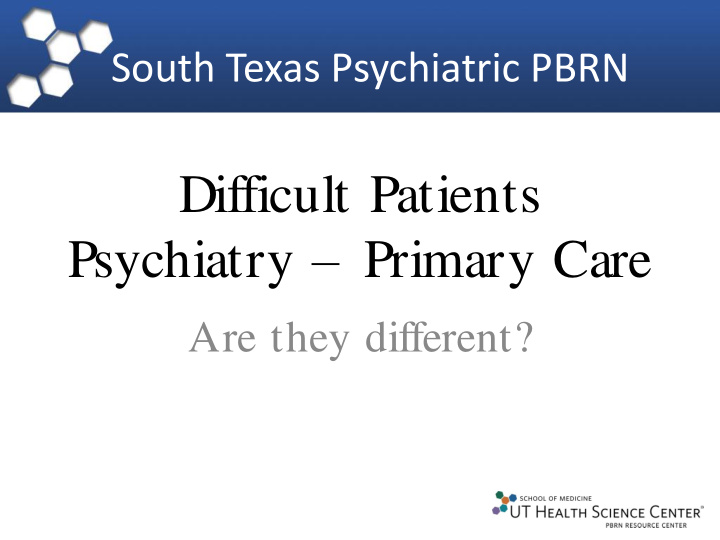



South Texas Psychiatric PBRN Difficult Patients Psychiatry – Primary Care Are they different?
Heart Sink Patients There are patients in every practice who give the doctor and staff a feeling of "heartsink" every time they consult. They evoke an overwhelming mixture of exasperation, defeat, and sometimes plain dislike that causes the heart to sink when they consult. Ellis, a general practitioner, coined the phrase "dysphoria" to define "the feelings felt in the pit of your stomach when their names are seen on the morning's appointment list.“ O’Dowd, TC, British Medical Journal 1988
Hateful Patients "Hateful patients" are not those with whom the physician has an occasional personality clash. As defined here they are those whom most physicians dread. The insatiable dependency of "hateful patients" leads to behaviors that group them into four stereotypes: dependent clingers , entitled demanders , manipulative help-rejecters and self-destructive deniers.” Groves, JE NEJM 1978
Hahn SR J Clin Epidemiology1994 • 113 primary care outpatients • 10-20 % Difficult (30 item DDPQ) • Difficulty independent of age, race, sex, total number and most types of medical diagnoses • Difficult patients: – Multiple somatic complaints – Axis I psychiatric diagnosis – Personality Disorder
Hahn SR J Gen Int Med 1996 • 627 primary care outpatients • 15 % Difficult • Difficult patients: – More likely to have psychiatric dx (67% v 25%) – More functional impairment – Higher healthcare utilization – Lower satisfaction with care
STPPBRN Difficult Patients • Pilot Study September 2009 • 11 psychiatrists • 492 patients • Do you have a negative reaction to this patient? Yes / No • What is patient diagnosis? • 10% of patients
STPPBRN Difficult Patients • Systematic assessment • What is prevalence of Difficult Patients in psychiatric practice? • What patient characteristics are associated with difficulty? • What psychiatrist characteristics are associated with difficulty? • How do difficult psychiatric patients compare to difficult primary care patients?
STPPBRN Difficult Patients • Patient Variables • Doctor Variables • Rating Difficulty
BACK Data Collection – Patient Variables
Data Collection – Physician Variables • Age • Sex • years in practice ( MIT, < 7yr, 7-15 yr, > 15 yr) • practice setting (solo, 2-5, Group > 6) • # hours worked per week (<40 hr, 40 – 45 hr, 46-50 hr, >50 hr) • ***role: med management vs. psychotherapist***
BACK Data Collection – Difficulty Rating
Procedure • The data was collected during the Month of April 2010 • 20 psychiatrists collected cards on 50 patients each either consecutively or by choosing one to two days a week to collect cards on their patients.
Psychiatrist Characteristics – Age and Sex Sex Age 8 7 6 5 Male 4 Female 3 Number 2 1 0 31-40 41-50 51-60 >61 yrs yrs (4) yrs (4) yrs (7) (5)
Psychiatrist Demographics Time in Current Setting Mean : 12.1 yrs (10.7 sd) Median: 8.5 yrs Min: 1 yr Max: 38 yrs
Patient Characteristics DDPRQ-10 Difficulty Score for 905 Patients 17.5 Mean 21.1 Median 19.0 15.0 N 905 Percent of Patients 12.5 10.0 7.5 5.0 2.5 0 9 12 15 18 21 24 27 30 33 36 39 42 45 48 51 54 57
Psychiatry PBRN Card Study 2 (17 June 2010) The Difficult Doctor-Patient Relationship Questionnaire Ten-Item Version (DDPRQ-10) Based on a DDPRQ-10 score > 30, out of 905 patients, 133 were Difficult % of Patients Rated Difficult by Item b Difficult Not Difficult Item a (n=133) (n=772) 1. How much are you looking forward to this patients next visit after 92 38 today? c 2. How frustrating do you find this patient? 80 9 3. How manipulative is this patient? 46 3 4. To what extent are you frustrated by this patients vague complaints? 55 4 5. How self-destructive is this patient? 52 6 6. Do you find yourself secretly hoping this patient will not return? 54 2 7. How at ease did you feel with this patient today? c 64 18 8. How time-consuming is caring for this patient? 61 10 9. How enthusiastic do you feel about caring for this patient? c 90 34 10. How difficult is it to communicate with this patient? 53 6
Difficult Patient Characteristics • The following items were significantly associated with an increased risk of being identified as difficult: – Diagnosis: Schizophrenia, Bipolar Disorder, Eating Disorder, any Personality Disorder, and Cognitive Disorder – Appointment Duration: < 19 minutes – Payor Source: Government (Medicaid, Medicare, TriCare) – Psychotropic medication
Difficult Patient Characteristics • The following items were significantly associated with an decreased risk of being identified as difficult: – Diagnosis: Depressive Disorder, Anxiety Disorder – Psychotherapy: In psychotherapy, In psychotherapy with psychiatrist
Difficult Patient Characteristics • The following items did not differentiate difficult from non difficult patients: – Diagnosis: PTSD, ADHD, any Axis III disorder – Age, Gender, or patient status
Difficult Doctors • There were no significant characteristics distinguishing “burdened” psychiatrists from “nonburdened” psychiatrists. • This would include: – years in practice, – type of practice, – payor source, – using psychotherapy, or – number of medications prescribed.
Conclusions • Difficult patients are present in primary care and psychiatric practices in the same prevalence, ~ 15% • Somatization, unexplained physical complaints, is a significant source of difficulty for primary care patients but not psychiatric patients
Recommend
More recommend